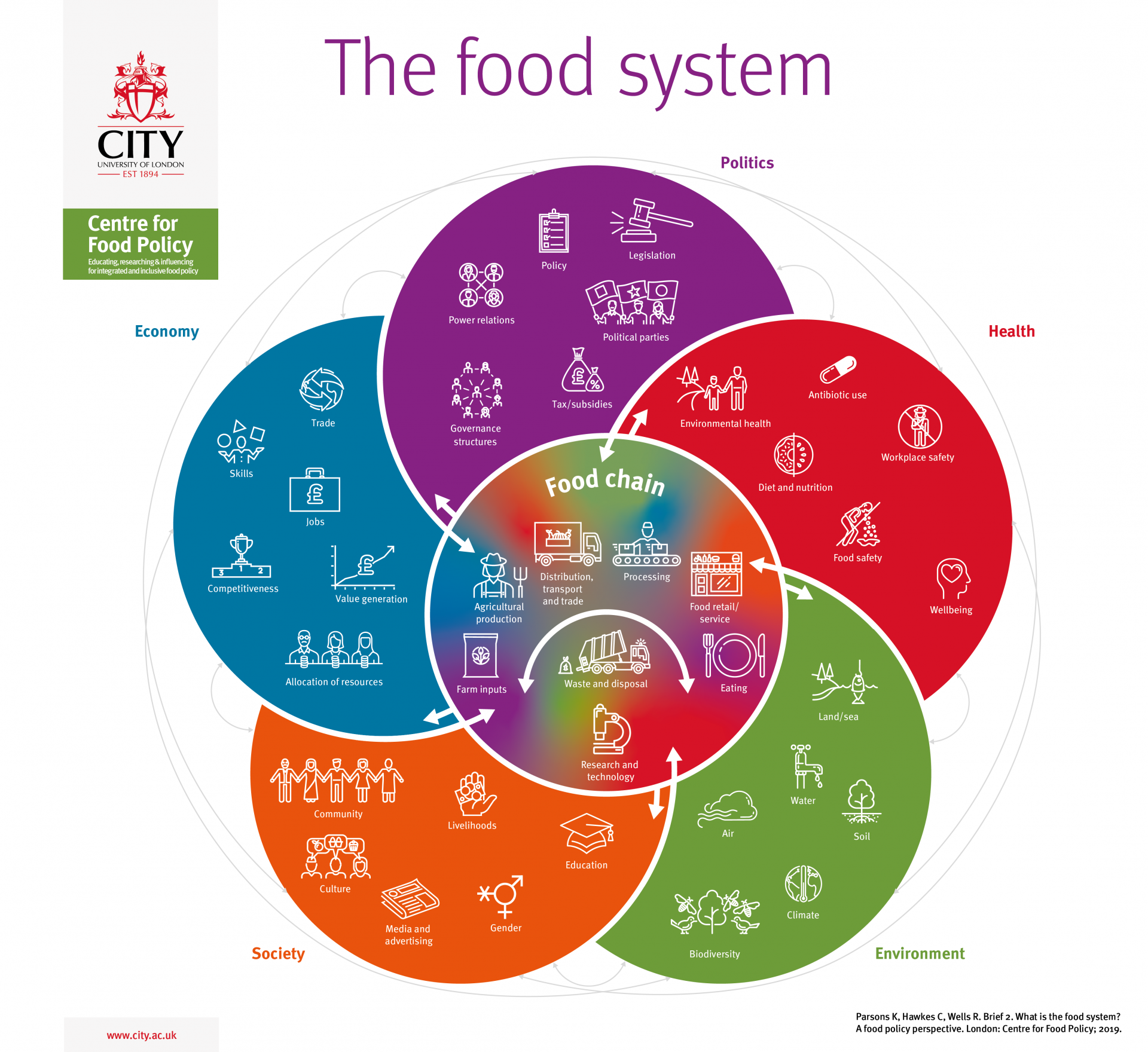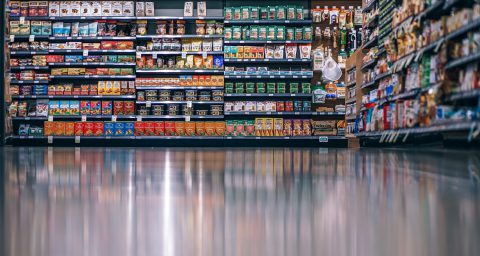The principle of joined-up food policy has been circulating for at least twenty years, but now is the time to put it into practice, says Kelly Parsons.
“The challenge of how to balance seemingly contrary policy initiatives – health, environment, consumer aspirations, commerce… is formidable. To accord priority to the protection of the environment, health, consumers and social justice will require considerable adjustment in policy and food practices, but can society and the environment afford not to do this?’’
– Lang, T. Agriculture and Human Values (1999) 16: 169. p14

This sentiment, which could have been expressed today, was actually penned two decades ago. The language may have changed, but strikingly similar calls continue to be made. With food implicated more than ever in the most significant health, environmental, economic, social and political challenges of our time, such calls are now being framed around the need to address ‘food systems’.
Food Systems – and their links to pressing policy issues like obesity and climate change – are on the agenda not just of national governments (1), but UN agencies at the global level (2), EU Directorates-General (3) and local level food policy councils (4). The recently launched UK Research and Innovation fund to Transform the UK Food System (5) is another sign that prioritising the health of people and the natural environment is as critical today as it was twenty years ago.
The role of policy in tackling food-systems challenges in a connected way is also gaining traction (6). The persistence of the problems – and increasing pressures on the food system – mean better policy is needed.
Rethinking food policy
The Centre for Food Policy’s ‘Rethinking Food Policy: A Fresh Approach to Policy and Practice’ series of briefs identifies how food policy could be done differently in the 21st century (7). The briefs examine big ideas around food systems, connections, coherence and governance through a food policy lens, with the aim of opening these often abstract concepts up to a wider audience of academics, policymakers, businesses and civil society organisations. The aim is to inspire and support people working on food issues to move beyond the broad principle of joining-up, and to take practical action to address challenges more holistically.
A key message is that food systems are shaped by many different decisions and decision-makers beyond what might historically have been considered ‘food policy’ (8). When it comes to public policy made by governments, these encompass not only obvious food-related policies on agriculture, trade, safety and nutrition, but decisions which affect food indirectly, such as social policy (which can limit how much money people have for food), or migration policy (which determines who works where in the food system).
The sheer number of policies, and a lack of transparency around which food-related areas are dealt with in which parts of government, can make it difficult to know the right levers to influence the system. My recent experience gathering data for a report on how UK food policy works, for the Food Research Collaboration (forthcoming (9)), emphasised how diffuse – and often opaque – the policies which impact the food system can be. Yet, understanding these policies is a crucial part of the evidence base when deciding how to transform it.
The connections between these many policies are also an important part of the picture because interventions that are made in isolation from each other risk creating incoherence. The divergent objectives, activities and outcomes of non-systemic interventions can make efforts to address food systems challenges less effective. For example, agricultural policy can undermine climate objectives, and activities to grow economies (such as signing an investment agreement which gives preference to the rights of international investors) may not be coherent with promoting healthy diets through taxation or labelling requirements on the products of those investors (10).
Aligning policies
The complex and interconnected nature of food systems can be overwhelming and challenging to translate into practical action. Brief 2 includes a representation of the food system; a visual thinking tool to help identify the interconnections and reverberations to be aware of when designing activities about food (11).

Coherence analysis is a specific tool which can then be used to better align the content of policies. Policy coherence is also about maximising opportunities to connect policies for ‘co-benefits’, such as a policy designed to increase plant-based diets for their health benefits which can also reinforce climate change objectives (12). Methods for assessing and addressing food policy coherence are the focus of the next Brief in the series, launching in November 2019.
There are also tools to better join-up the process of policy making. Several emerging approaches to developing more ‘integrated food policy’ are discussed in Brief 3 (13). These include: bringing together different policy areas into a national cross-cutting policy (like England’s forthcoming National Food Strategy (14)) or embedding food into other policy sectors. This latter ‘Food in all Policies’ type of integration has been used successfully to make connections across local food systems, and has potential to transfer to national level (15).
From ideas to action
Transforming the food system will require transforming both the content of policies and the processes they are made through. It will involve interrogating existing policies to see if they are undermining goals elsewhere in the system, and whether they align with a vision of what we want our food system to look like. More ambitious connections should be explored and implemented, particularly between nutrition and climate change objectives, as well as agricultural-, trade- and other policies which impact the food supply.
Moving from a big idea to action won’t be easy. There will be (often highly political) trade-offs between policy objectives to be navigated, and governance systems will need to be made fit for purpose in a more connected era.
But, in England at least, the stars are aligning. The necessary steps to create better, more integrated and coherent decision making are clearer. The forthcoming National Food Strategy should deliver an overarching vision of what we want the food system to look like. Evidence of what actions on the ground can produce healthy and sustainable food systems (and what trade-offs and policy design they involve), will be created through the Transforming the UK Food System funding.
This should ensure we are not still talking about the need to better align policies to support the health of people and planet in twenty years’ time.
About the author
Dr Kelly Parsons is a post-doctoral researcher specialising in food policy, food systems and integrated policy and governance. The Rethinking Food Policy and UK Food Governance projects mentioned above were funded by Wellcome and Esmee Fairbairn Foundation respectively, as part of a research fellowship at the Centre for Food Policy, City University of London (February 2018-October 2019).
References
- https://knowledge4food.net/wp-content/uploads/2018/07/20180630_FoodSystemsReport-WUR.pdf
- http://www.fao.org/economic/nutrition/en/
- https://ec.europa.eu/research/bioeconomy/index.cfm?pg=policy&lib=food2030
- http://www.milanurbanfoodpolicypact.org/wp-content/uploads/2018/10/CA0912EN.pdf
- https://bbsrc.ukri.org/funding/filter/transforming-the-uk-food-system-for-healthy-people-and-a-healthy-environment-call/
- https://www.city.ac.uk/__data/assets/pdf_file/0008/446930/Connecting-food-systems-for-co-benefits-Hawkes-and-Parsons-Nov-2018.pdf
- https://www.city.ac.uk/about/schools/health-sciences/research/centre-for-food-policy
- https://www.city.ac.uk/__data/assets/pdf_file/0003/466347/7643_Brief-1_Tackling-food-systems-challenges_the-role-of-food-policy_WEB_SP.pdf
- https://foodresearch.org.uk/workstream-2/
- https://academic.oup.com/heapro/article/33/4/561/2897774
- https://www.city.ac.uk/__data/assets/pdf_file/0008/471599/7643_Brief-2_What-is-the-food-system-A-food-policy-perspective_WEB_SP.pdf
- https://www.city.ac.uk/__data/assets/pdf_file/0008/446930/Connecting-food-systems-for-co-benefits-Hawkes-and-Parsons-Nov-2018.pdf
- https://www.city.ac.uk/__data/assets/pdf_file/0008/491174/7643_Brief-3_Integrated_food_policy_What_is_it_and_how_can_it_help_connect_food_systems_WEB_SP.pdf
- https://www.nationalfoodstrategy.org
- https://www.city.ac.uk/__data/assets/pdf_file/0011/493625/7643_Brief-4_Embedding_food_in_all_policies_WEB_SP.pdf



